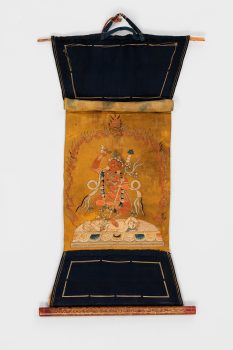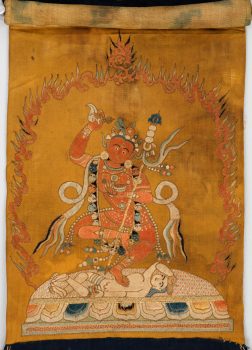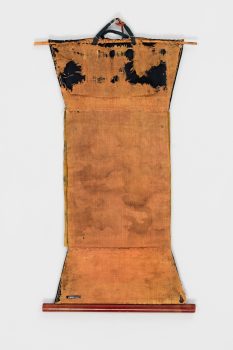Tibet
19th century



Tibet
19th century



Depictions of Vajravarahi, or the sow-faced goddess, usually portray her red in color, but this embroidered image was created with silk thread, which may have been red in tone and faded overtime. Varahi derives her name from the small sow head atop her own. Ancient Indic traditions hold that pigs are skilled in uprooting things. In Buddhist tantric practices, she is the focus of meditations that help to uproot ego.Both peaceful and wrathful, red in color, she has one face and two hands. Her right hand holds aloft a curved knife for severing mental afflictions. Her left holds a skull cup to her heart. A staff with a blue tip leans against her shoulder. A white scarf unfurls and twists about her upper body. Adorned with bone ornaments, she also wears a garland of variously colored severed heads. Atop the prone figure of uprooted ego, she dances with her right leg drawn up, surrounded by the flames of wisdom. Small sacred works of art such as this one, embroidered or painted, are meant for personal use.
A religious movement that originated in India around the fifth to seventh century with sacred writings and esoteric teachings and practices transmitted from teacher to student through initiation. These remain an important part of Hinduism and Buddhism today.
A kind of energy that can be used, individually and collectively, to effect change.
Female bodhisattvas and tantric deities embody specific enlightened qualities such as wisdom, power, and protection, and can be peaceful or wrathful in appearance.
Today, Tibetans primarily inhabit the Tibetan Plateau, situated between the Himalayan mountain range and the Indian subcontinent to the west, Chinese cultural regions to the east, and Mongolian cultural regions to the northeast. During the 7th to 9th century, Tibetan rulers expanded their empire across Central Asia, and established Buddhism as the state religion.
Get the latest news and stories from the Rubin, plus occasional information on how to support our work.